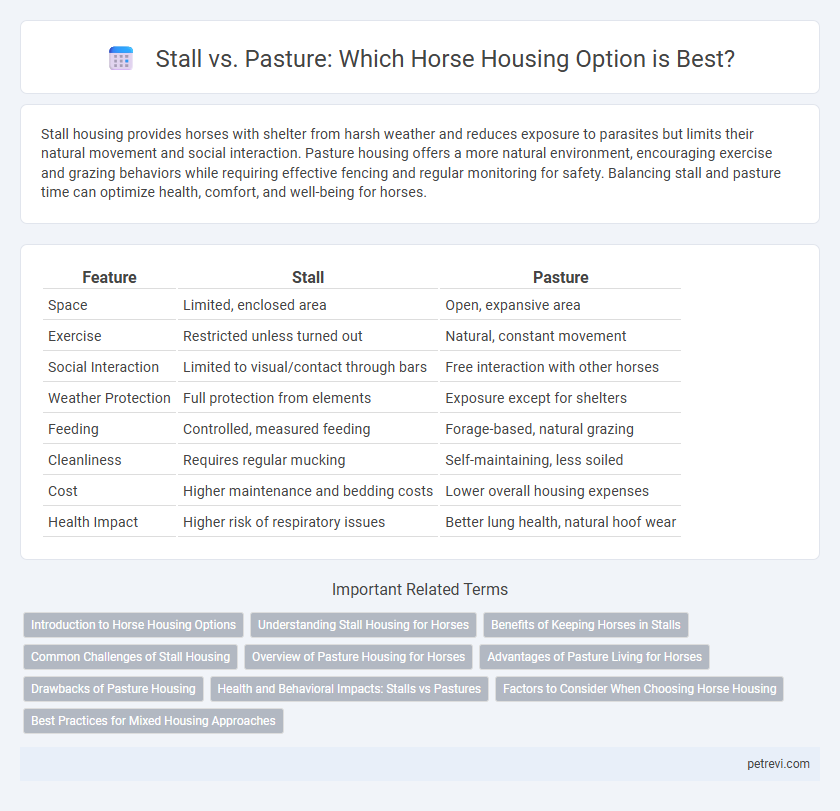Stall housing provides horses with shelter from harsh weather and reduces exposure to parasites but limits their natural movement and social interaction. Pasture housing offers a more natural environment, encouraging exercise and grazing behaviors while requiring effective fencing and regular monitoring for safety. Balancing stall and pasture time can optimize health, comfort, and well-being for horses.
Table of Comparison
| Feature | Stall | Pasture |
|---|---|---|
| Space | Limited, enclosed area | Open, expansive area |
| Exercise | Restricted unless turned out | Natural, constant movement |
| Social Interaction | Limited to visual/contact through bars | Free interaction with other horses |
| Weather Protection | Full protection from elements | Exposure except for shelters |
| Feeding | Controlled, measured feeding | Forage-based, natural grazing |
| Cleanliness | Requires regular mucking | Self-maintaining, less soiled |
| Cost | Higher maintenance and bedding costs | Lower overall housing expenses |
| Health Impact | Higher risk of respiratory issues | Better lung health, natural hoof wear |
Introduction to Horse Housing Options
Stall and pasture are two primary horse housing options that cater to different needs and management styles. Stalls provide controlled environments for individual horses, offering protection from weather and close monitoring of health and diet. Pastures allow horses to graze freely, promoting natural behaviors and social interaction, essential for physical and mental well-being.
Understanding Stall Housing for Horses
Stall housing provides horses with a controlled environment protecting them from harsh weather and predators, essential for managing health and safety. Proper ventilation and adequate space within the stall are critical factors in preventing respiratory issues and promoting comfort. Regular cleaning and well-maintained bedding reduce the risk of infections and hoof problems, enhancing overall equine welfare.
Benefits of Keeping Horses in Stalls
Keeping horses in stalls provides controlled environmental conditions that protect them from extreme weather, reducing the risk of illness and injury. Stalls allow for individualized feeding schedules and diet management, crucial for horses with specific dietary needs or health issues. They also enable easier monitoring and handling, facilitating regular grooming, veterinary care, and exercise routines to maintain optimal health.
Common Challenges of Stall Housing
Stall housing for horses often presents challenges such as limited movement, leading to stiffness and muscle atrophy. Poor ventilation within stalls can increase the risk of respiratory issues due to ammonia buildup from urine. Social isolation in stalls may cause stress and behavioral problems, reducing overall equine well-being.
Overview of Pasture Housing for Horses
Pasture housing for horses offers natural grazing opportunities and promotes physical activity, leading to improved digestive health and mental well-being. It requires appropriate fencing, regular pasture maintenance, and rotational grazing to prevent overgrazing and maintain grass quality. Weather conditions and parasite control must be managed carefully to ensure a safe and healthy environment for horses living outdoors.
Advantages of Pasture Living for Horses
Pasture living for horses promotes natural behavior, improves mental well-being, and provides continuous access to fresh forage, which supports better digestion and reduces the risk of colic. Horses in pasture environments benefit from increased exercise and social interaction, enhancing muscle tone and reducing stress-related behaviors. Exposure to sunlight in pastures also aids in vitamin D synthesis, crucial for healthy bone development and immune function.
Drawbacks of Pasture Housing
Pasture housing for horses can lead to uneven nutrition due to seasonal grass variability and overgrazing risks, which may result in weight loss or deficiencies. Exposure to parasites, insects, and harsh weather conditions increases health challenges such as laminitis and respiratory issues. Limited shelter options in pastures can also cause stress and injuries from environmental factors or aggressive herd behavior.
Health and Behavioral Impacts: Stalls vs Pastures
Horses housed in stalls often face increased risks of respiratory issues and muscle stiffness due to limited movement, while pasture housing promotes natural behaviors such as grazing and social interaction, enhancing mental well-being. Prolonged stall confinement can lead to stress-related behaviors like cribbing or weaving, whereas access to pasture reduces these tendencies by providing an enriched environment. Pasture turnout supports better hoof health and digestive function through continuous forage intake, contrasting with the restricted dietary variety in stalls.
Factors to Consider When Choosing Horse Housing
Choosing between stall and pasture housing for horses depends on factors such as climate, horse health, and activity levels. Stalls offer protection from harsh weather and facilitate easier management of medical conditions, while pastures provide natural exercise and social interaction. Consideration of available space, horse temperament, and nutritional needs also plays a crucial role in determining the most suitable housing option.
Best Practices for Mixed Housing Approaches
Combining stalls with pasture space enhances horse welfare by balancing shelter and natural grazing opportunities, reducing stress and promoting physical health. Integrating daily turnout routines allows horses to benefit from fresh air and social interactions while relying on stalls for rest, safety, and protection from harsh weather. Optimal mixed housing practices include ensuring secure fencing, providing adequate shelter within pastures, and maintaining clean, dry stalls to minimize disease risks and encourage natural behaviors.
Stall vs Pasture for Horse Housing Infographic

 petrevi.com
petrevi.com